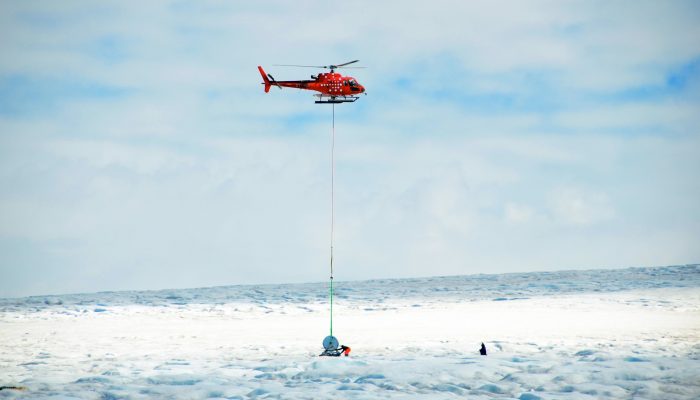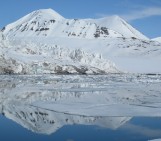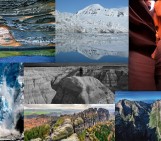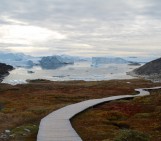
How do you get heavy machinery, such as a drill spool onto an ice sheet? This week’s imaggeo on Mondays’ photography captures the freighting of components of a hot water drill to directly access and observe the physical and geothermal properties at the ice-bed interface. In the image, SAFIRE principal investigator Bryn Hubbard and post-doc Sam Doyle help fly in the drill spool at the start of the Summer 2014 field campaign on Store Glacier, Western Greenland.
Freighting several tons of equipment onto the Greenland Ice Sheet for the sake of science may be slightly intense, but in doing so, it reveals an environment that is complex in history and dynamics.
The Greenland Ice Sheet is losing mass at an increasing rate, and since 2010 has contributed 1 mm/year to global sea level rise. The large majority of changes occur within the drainage basins of marine-terminating glaciers (those which end at the lands edge and drain into the sea), which flow rapidly and drain 88% of the ice sheet. While the surface melt processes of glaciers has been well-studied and quantified, very little is known about what happens below the glacier surface, especially where the ice meets the bedrock.
Recent studies from Greenlandic outlet glaciers have emphasized meltwater-enhanced basal lubrication as an increasingly important mechanism to explain the flow of ice down a glacier. In essence, meltwater generated at the glacier surface will eventually find its way down to the glacier bed through crevasses that connect these two systems. The sudden influx of water increases the pressure within the environment, causing the glacier to “lift” off the bed and flow faster. However, the mechanism is largely an untested theory, and its specifics at the ice-bed interface are still largely unknown, especially on fast-flowing outlet glaciers. In order to achieve accurate predictions of sea level rise in the near future, we need to fully understand the dynamics occurring at the ice-bed interface and its complex response to climate-induced ice melt.
Obviously, a great method to tackle this research question is to air freight tons of heavy machinery onto the Greenland Ice Sheet, and to gain access to the bed of the ice sheet by drilling a 600-metre tunnel with hot water. This is part of the Subglacial Access and Fast Ice Research Experiment (SAFIRE), a collaboration between the Scott Polar Research Institute at the University of Cambridge and Aberystwyth University in Wales.
The SAFIRE project has two specific goals: 1. to identify and characterise the mechanical and hydrological conditions at the base of a large outlet glacier in Greenland, using instruments installed in boreholes drilled to the bed; and 2. to determine the role of basal processes in governing ice flow and iceberg calving. With no previous observation ever made in a subglacial environment of this type of glacier, this project breaks new ground, and from the unique datasets acquired from instruments deployed in boreholes and on the glacier’s surface, higher order numerical ice-flow models can be written and constrained.
Our work is mainly on Store Glacier, which is a large tidewater glacier in the Uummannaq region of northwestern Greenland. Store has a large drainage basin (35,000 km2) and flows up to 5 km/year at the glacier terminus, discharging extremely large volumes of ice into the ocean every day. Since 2014, we have been working on-site at a campsite ~30 km from the terminus, and our results characterise an extremely dynamic and warm basal environment over a deformable sediment bed. A detailed analysis of these unexpected results will be forthcoming in the near future.
By TJ Young, Scott Polar Research Institute / British Antarctic Survey
Imaggeo is the EGU’s online open access geosciences image repository. All geoscientists (and others) can submit their photographs and videos to this repository and, since it is open access, these images can be used for free by scientists for their presentations or publications, by educators and the general public, and some images can even be used freely for commercial purposes. Photographers also retain full rights of use, as Imaggeo images are licensed and distributed by the EGU under a Creative Commons licence. Submit your photos at http://imaggeo.egu.eu/upload/.



